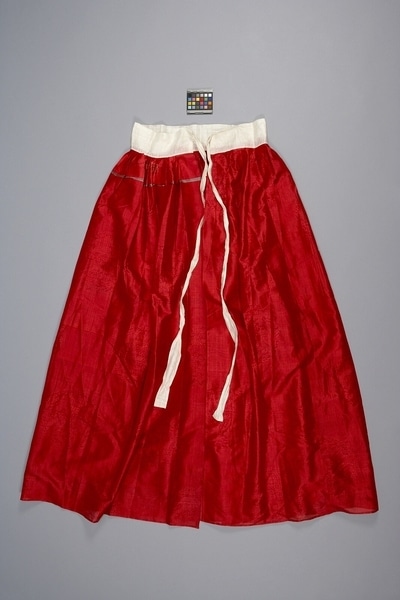Skirt Item Number: N3.17 from the MOA: University of British Columbia


Description
Skirt made of red rayon gauze damask, patterned with roundels of paired dragons, called “ssang-yang-mun-sa”. Skirt is formed of three and one-half loom-width panels, pleated onto white waistband with long ties, all made of ramie. The skirt opens completely at the back. At the top edge of the right panel five Chinese characters are woven with gold thread; below them are two parallel green bands. The left upper edge is pulled up very slightly into the waistband, thus raising the bottom edge at that point. One tie is detached from waistband.
History Of Use
Such skirts “chima” would be worn for celebrations or going out on a special day, by a new bride after her marriage. They are longer than other “chima”. “Chima” of such lightweight fabric were worn in summer. After 1894, when Korea was opened to the outside world, missionaries pressured their female students to use straps to hold up their “chima”, to conform to the missionaries’ ideas of decency. During the Chosun Dynasty, only the royal family could use dragon images. These restrictions disappeared in the late Chosun period.
Iconographic Meaning
Generally double dragons can be used by married couples to represent prosperity, respect for each other, and nobility. Those woven in gold were used only in the court.
Specific Techniques
All hand-sewn. Invisible sewing was used for hem, as fabric is too stiff to paste. The “chima” is made of 3 ½ panels each 72 cm. wide because four panels would be too bulky, which means that one edge of the opening had to be finished with stitching. The pleats and seams are oriented to the right.
Item History
- Made in Korea before 1939
- Collected between 1899 and 1939
- Owned by Marion Stephan before August 1964
- Received from Marion Stephan (Donor) during August 1964
What
- Name
- Skirt
- Identification Number
- N3.17
- Type of Item
- skirt
- Material
- rayon fibre, dye, ramie fibre and metal
- Manufacturing Technique
- woven, cut, pleated and sewn
- Overall
- height 126.0 cm, width 257.5 cm
Who
- Culture
- Korean
- Previous Owner
- Marion Stephan
- Received from
- Marion Stephan (Donor)
Where
- Holding Institution
- MOA: University of British Columbia
- Made in
- Korea
When
- Creation Date
- before 1939
- Collection Date
- between 1899 and 1939
- Ownership Date
- before August 1964
- Acquisition Date
- during August 1964
Other
- Item Classes
- textiles
- Condition
- good
- Accession Number
- 0113/0072